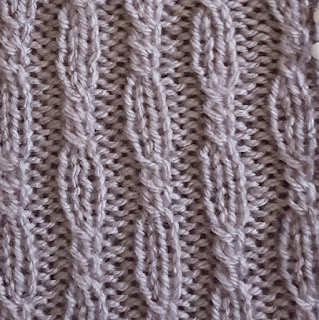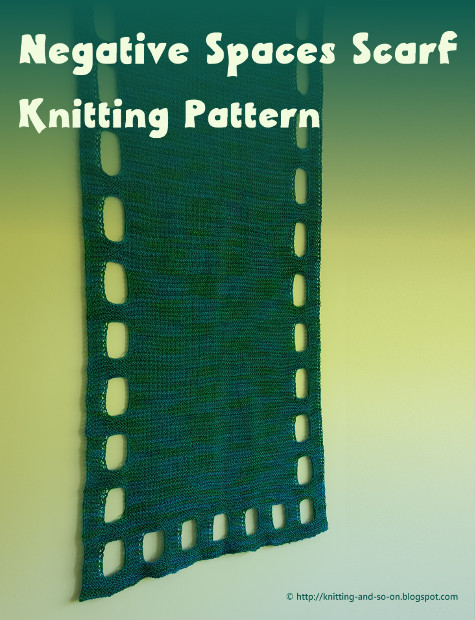These pieces can be used as potholders, hotpads, washcloths or coasters. The construction is similar to my Pumpkin Potholders of last year. It's a combination of short rows and intarsia. Since it is a small piece of knitting, it's great to learn a new technique.

This work by Knitting and so on is licensed under a Creative Commons Attribution-NonCommercial-ShareAlike 4.0 International License.

Materials
- about 30 grams of Aran weight yarn in two colors - the main color (MC) for the body of the pear and a contrast color (CC) for the contour and the stem
- 4 mm knitting needles
- a tapestry needle to weave in ends
Size and Gauge
The finished piece measures 14 cm at the widest point, 21 cm at the highest point (without the stem)
I counted about 9 stitches for 5 cm in width and about 10 ridges for 5 cm in height.
Techniques and Abbreviations
- Short rows with wrap and turn (w+t) - as shown in this YouTube video by Very Pink Knits.
- Intarsia: Changing colors with the intarsia technique - as shown in this YouTube video by knitwithpat; or this YouTube video by Francoise Danoy. This technique will be used only a few times in this pattern. But it helps to make sure that the WS looks OK as well - see picture below.
- Throughout the pattern, the following notation will be used: "CC (k2); MC (k13, t+p, k12); CC(k2)" means "knit 2 sts with CC; change to MC and knit 13, do a turn an pull, knit 12 stitches with MC; change back to CC and knit the 2 stitches - i.e. before the brackets the yarn is defined and the instructions are given inside the brackets.
- Please note that for this pattern the last 2 stitches in CC of a row (when they are reached after using the MC - which only happens a few times) are knitted with the tail of that was left over by the long tail CO. That way, it is not necessary to use a 2nd skein or bobbin in CC - and it also avoids two more ends to weave in :) See photo below. Here, e.g. CCtail (k2, turn, sl1, k1) means "with the tail of CC knit 2 stitches, turn, sl1 and k1". In order to avoid a second skein or bobbin (and two more ends to weave in). You're asked to leave a tail of your CO and knit with it. See photo below.
- Knitted Cast-On: See this Youtube-video by Very Pink Knits - used to craft the pumpkin's stem.
- kfb: knit front & back - an increase
- ssk: slip slip knit - a left leaning decrease
With CC and a long tail CO cast on 56 sts but leave a tail that is about 1m long. This tail called is CCtail and will be used to knit a few stitches at the bottom of the pear).
Knit 1 row in CC
[1] RS CC (sl1, k1), MC (k52, w+t,
WS k36, w+t
[2] RS k1, ssk, k25, ssk, ssk, k2, w+t,
WS k45, w+t
[3] RS k1, ssk, k13, ssk, k8, ssk, k11, ssk, k2, w+t,
WS k37, w+t
[4] RS k1, ssk, k11, ssk, k13, ssk, ssk, k2, w+t,
WS k18, w+t
[5] RS k1, ssk, k16, ssk, k2, w+t,
WS k35, w+t
[6] RS k1, ssk, k13, ssk, k12, ssk, k2 w+t,
WS k24, w+t
[7] RS k12, ssk, k7, ssk, k3) CCtail (k2, turn,
WS sl1, k1), MC (k34), CC (k2)
[8] RS CC (sl1, k1), MC (k1, ssk, k16, ssk, k8, w+t,
WS k27, w+t
[9] RS k1, ssk, k26, w+t,
WS k27, w+t
[10] RS k1, ssk, k15, ssk, k8, w+t,
WS k27), CC (k2, CO 8 with knitted cast on)
[11] RS CC(k3, kfb, k1, kfb, k2 ktbl, k1), MC (k22, w+t,
WS k8, w+t
[12] RS k15, CCtail (k2, turn
WS sl1, k1), MC (k29), CC (k16, kfb, k5)
[13] RS CC (BO11, k2), MC (k19, kfb, k2, w+t,
WS k16, w+t
[14] RS k17, kfb, k2, w+t,
WS k24, w+t
[15] RS k1, kfb, k18, k1, w+t,
WS k17, w+t
[16] RS k2, kfb, k13, kfb, k3, w+t,
WS k31, w+t
Knit 1 row in CC
[1] RS CC (sl1, k1), MC (k52, w+t,
WS k36, w+t
[2] RS k1, ssk, k25, ssk, ssk, k2, w+t,
WS k45, w+t
[3] RS k1, ssk, k13, ssk, k8, ssk, k11, ssk, k2, w+t,
WS k37, w+t
[4] RS k1, ssk, k11, ssk, k13, ssk, ssk, k2, w+t,
WS k18, w+t
[5] RS k1, ssk, k16, ssk, k2, w+t,
WS k35, w+t
[6] RS k1, ssk, k13, ssk, k12, ssk, k2 w+t,
WS k24, w+t
[7] RS k12, ssk, k7, ssk, k3) CCtail (k2, turn,
WS sl1, k1), MC (k34), CC (k2)
[8] RS CC (sl1, k1), MC (k1, ssk, k16, ssk, k8, w+t,
WS k27, w+t
[9] RS k1, ssk, k26, w+t,
WS k27, w+t
[10] RS k1, ssk, k15, ssk, k8, w+t,
WS k27), CC (k2, CO 8 with knitted cast on)
[11] RS CC(k3, kfb, k1, kfb, k2 ktbl, k1), MC (k22, w+t,
WS k8, w+t
[12] RS k15, CCtail (k2, turn
WS sl1, k1), MC (k29), CC (k16, kfb, k5)
[13] RS CC (BO11, k2), MC (k19, kfb, k2, w+t,
WS k16, w+t
[14] RS k17, kfb, k2, w+t,
WS k24, w+t
[15] RS k1, kfb, k18, k1, w+t,
WS k17, w+t
[16] RS k2, kfb, k13, kfb, k3, w+t,
WS k31, w+t
[17] RS k1, kfb, k8, kfb, k13, kfb, k2, w+t,
WS k32), CC (k2)
[18] RS CC (sl1, k1), MC (k2, kfb, k12, kfb, k10, kfb, k1, w+t,
WS k16, w+t
[19] RS k2, kfb, k14, kfb, k1, w+t,
WS k33, w+t
[20] RS k1, kfb, k14, kfb, k16, kfb, k7), CCtail (k2, turn
WS sl1, k1), MC (k45, w+t
[21] RS k2, kfb, k32, kfb, w+t,
WS k19, w+t
[22] RS k2, kfb, k17, kfb, kfb, w+t,
 WS k39, w+t
WS k39, w+t
[23] RS k1, kfb, k41, w+t,
WS k50), CC (k2)
[24] RS CC (sl1, k all
WS sl1, k all
Bind off in CC.
Once you've finished your pear there will be a small indentation at the bottom of the pear. This can be sewn closed with the tail end of your yarn before weaving in the end.WS k32), CC (k2)
[18] RS CC (sl1, k1), MC (k2, kfb, k12, kfb, k10, kfb, k1, w+t,
WS k16, w+t
[19] RS k2, kfb, k14, kfb, k1, w+t,
WS k33, w+t
[20] RS k1, kfb, k14, kfb, k16, kfb, k7), CCtail (k2, turn
WS sl1, k1), MC (k45, w+t
[21] RS k2, kfb, k32, kfb, w+t,
WS k19, w+t
[22] RS k2, kfb, k17, kfb, kfb, w+t,
 WS k39, w+t
WS k39, w+t[23] RS k1, kfb, k41, w+t,
WS k50), CC (k2)
[24] RS CC (sl1, k all
WS sl1, k all
Bind off in CC.





































